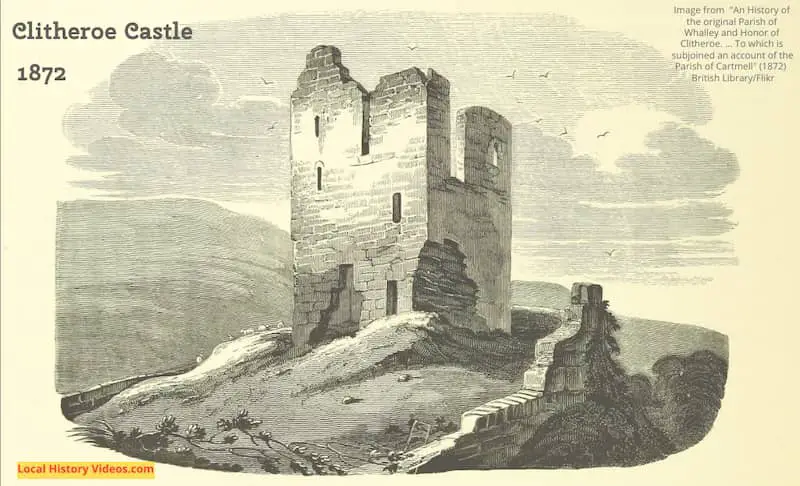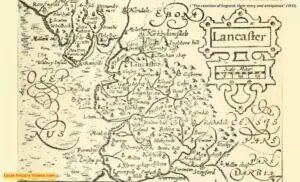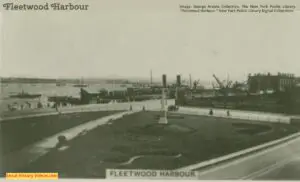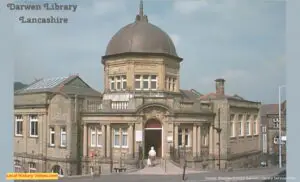Glimpse history through old images of Clitheroe, in Lancashire, England.
Princess Mary 1927
Near Clitheroe is Waddow Hall, a 17th-century Grade II listed building set in a 178-acre estate. It serves as a conference and activity centre for Girlguiding UK.
Back in 1927, at the opening of the new Girl Guides’ home, Princess Mary arrived in Guides’ uniform to meet the local women and girls involved with the movement.
Mary, Princess Royal and Countess of Harewood, was the daughter of King George V and Queen Mary, sister of kings Edward VIII and George VI, and aunt of Queen Elizabeth II.
Princess Mary at Clitheroe (1927) – British Pathé on YouTube
Clitheroe Gas Works
Coal gas production at the Clitheroe Gas Works ended in 1968.
This video on YouTube shows two vinatge short films about the industry and its history, including many views of the local streets more than half a century ago.
Clitheroe Gas Works – kendalmcguffie on YouTube
Buses 2001
Although the focus of this trailer for a PMPfilms transport DVD are the buses, we see many businesses, homes, passing cars, passengers and pedestrians.
CLITHEROE BUSES 2001 – DaveSpencer32 on YouTube
Clitheroe in 2008
A home movie showing the quiet streets of this pretty town in 2008.
The music is a Bolviam song called “quando el passo clitheroe” written in honour of the Lancahsire town’s twinning with Pechenecio in Bolivia.
CLITHEROE IN LANCASHIRE – newsandbuzz on YouTube
Historic Book
Extract from “Black’s Guide to England and Wales … Tenth Edition” by Adam Black
Published in 1872
Page 340
“CLITHEROE is situated on an eminence on the east bank of the Ribble . Here
are the ruins of an ancient castle , erected by the Lacys , who came over with the
Conqueror . The male line of this family became extinct in 1193 , and the honour
of Clitheroe passed afterwards into the possession of the famous John of Gaunt
and when his son became Henry IV . It was vested in the crown , remaining so
till the time of Charles II . It is now the property of the Buccleuch family .
During the commonwealth , Clitheroe castle was dismantled by order of the Par
liament , and is now greatly dilapidated . Its stones contributed to build a modern
mansion , which stands within its precincts . Clitheroe has an excellent gram
mar school , and several churches and chapels . In the vicinity of the town are
extensive cotton printing works . Two miles distant is Pendle hill , 1808 feet
above the level of the sea . One M.P. Pop . 8000 .”
Extract from “Rambles by the Ribble – Volume 3” by William Dobson
Published in 1881
Pages 155-158
“Leaving Dule upo ‘ Dun , I came upon a spot which , even now , old
Clitheroe men and women can scarcely pass without a shudder .
In the same lane where Dule upo ‘ Dun stood , an event occurred
above a hundred years ago , which is yet talked about by the inhabi
tants of Clitheroe . On the night of the 25th of March , in the
year 1773 , one George Battersby , of Slaidburn , a cattle jobber ,
accustomed to attend the markets at Clitheroe and the neighbour
hood , was seen for the last time alive . On that night shrieks were
heard in this lane . Three years afterwards , a dead body , con
siderably decomposed , was found in the bone house of the church ,
having been apparently recently taken there , and presenting the ap
pearance of having been burned in a lime pit . Suspicion was di
rected against four men , and ultimately three were apprehended ,
and tried at Lancaster Assizes , in April , 1778 ; upwards of five years
after the commission of the alleged crime . They were ,
however , acquitted , the judge ruling in favour of the prisoners ,
because , the body being considerably decomposed , there was no
proof that it was Battersby’s . There was , however , very strong
circumstantial evidence to prove that the body was Battersby’s ,
and that the prisoners had murdered him , and such was ever the
belief of the Clitheroe people . The barbarity of the crime , the
respectable position of the accused ( one was a publican , one was a
butcher , and one a barber ) , the want of motive for such a crime
( for all that was alleged was a grievance felt by the butchers at
Battersby interfering with their business ) , the mystery which
shrouded the affair , the long time that elapsed between the com
mission of the crime and the trial , and the acquittal of the ac
cused , all made the affair the great topic of conversation in the
place for years afterwards ; and even at the present time , ” old
Battersby’s murder ” is considered , among a large portion of the
Clitheroe people , the great event in the annals of the borough .
It would need little more than a brief allusion to this crime to
exite the garrulity of a Clitheroe person . Indeed , conversation .
about anything else of interest connected with Clitheroe would ,
with many an old person , most assuredly drift to the tale of old
Battersby . Dr. St. Clare , afterwards of Preston , was then a
surgeon at Clitheroe , and he gave evidence at the trial , having
made an examination of the remains . At Clitheroe , the doctor
acquired the reputation of a skilful medical man , which led to his
removal to Preston , as a wider sphere of labour , where he lived
for many years . He died in the year 1822. A monument to his
memory , the proceeds of a public subscription , is in the chancel
of the Preston parish church .
Upon one occasion when I was at Clitheroe I met an old inhabi
tant who knew much of Clitheroe’s history and traditions , whose
memory extended to the days when Battersby’s murder was a
recent occurrence , who knew the men charged with the offence ,
and who could tell of remorseful sufferings which they were
believed to have undergone . He could also tell of the feud at the
election of 1780 , between the Listers and the Curzons , and of the
stirs at many an election in times past . He gossipped about the
bull baits which were formerly held at Chatburn , the discontinuance
of which he appeared sadly to lament , and which he attributed to
effeminacy , reminding one of the person in the same neighbourhood
who , during a season of commercial distress , remarked , not very
logically , it must be admitted , that there never had been any good
times since bull baiting was ” put down . ” He could tell , too , of
the larking of his younger days , and how , in Clitheroe and the
neighbourhood a day , or rather a night , was set apart for larks .
” Mischief night ” it was usually called , and on that night , the eve
of May – day ( April 30th ) , the young men of the district were ac
customed to remove gates from their posts , to take carts from farm
yards and upset them into ditches , or by the road side ; to open
stable doors and let horses at large , and , in short , as the name ex
pressed it , to do as much ” mischief ” as they could . Although not
observed to as great an extent as formerly , ” mischief night ” is
yet observed in Clitheroe and the neighbourhood , as well as in the
neighbourhood of Blackburn , Burnley , Colne , and other places in
East Lancashire , and , sometimes , with anything but pleasant re
sults to the parties concerned . Sometimes branches of trees or
shrubs were placed at the doors of parties , and every tree had its
significance , as every flower is supposed to have a symbol in the
” language of flowers . ” A thorn meant scorn ; a quicken or wicken
was ” for my dear chicken ; ” a branch of a holly meant ” great
folly . ” Salt before the door signified that inside dwelt an un
chaste female , and there were numerous other ways of testifying
popular or individual opinion of the merits or demerits of friends
and neighbours . The custom , I believe , had its origin in the
ancient worship of the goddess Flora , and is connected with the
worship of Baal , and the introduction of the Bel – tain , or fires
lighted in honour of Baal . The custom of lighting fires on the hills
is still observed in the highlands of Scotland , though Baal is no
longer thought of , for in later times the fires became useful as means
of warning or alarm . May – day has ever been a festival held
in high honour ; its eve is strangely celebrated .
On one occasion , several tall men passed , which occasioned a
remark that there were some ” big fellows ” about Clitheroe . ” Aye , “
we were told , ” but not like there used to be , ” for my informant
considered that there were giants in the olden time at Clitheroe . I
once heard of a caravan coming to Clitheroe fair , bearing a ” giant “
for exhibition . The fairs at Clitheroe , as at other places , have sadly
degenerated , although many people who visit them , were they , like
honest Nicholas Assheton , to keep a diary , and daily record their
sayings and doings , might enter therein , that , after being at Clithe
roe fair , ” we were late to our beds . ” But to the giant . As soon
as the exhibition opened , a tall fellow , some six feet six or seven
inches in height , went round the town , picked up two or three as
tall , or nearly as tall , men as himself , went to the caravan , paid
their penny each for admission , and waited to see the giant . None
was forthcoming ; however , the curtain was drawn a little aside ;
” stock was taken ” of the new comers ; it was seen that the least
of the party was taller than the ” giant ; ” a message was sent out
that the giant was ill , and could not exhibit ; the money was
returned to the would – be sight seers ; the caravan was put into
travelling order , and in a few hours was on its way , giant and all ,
to a district where the inhabitants partook more of the stature of
Lilliput than Brobdignag . Two of the tall visitors to the show on
that occasion long afterwards lived in Preston .”
More about Lancashire
- Old Images of Lancashire, England
- Old Images of Skelmersdale, Lancashire
- Old Images of Haslingden, Lancashire
- Old Images of Fleetwood, Lancashire
- Old Images of Darwen, Lancashire
- Old Images of Colne, Lancashire
More Lancashire local history resources
Back to Home Page






